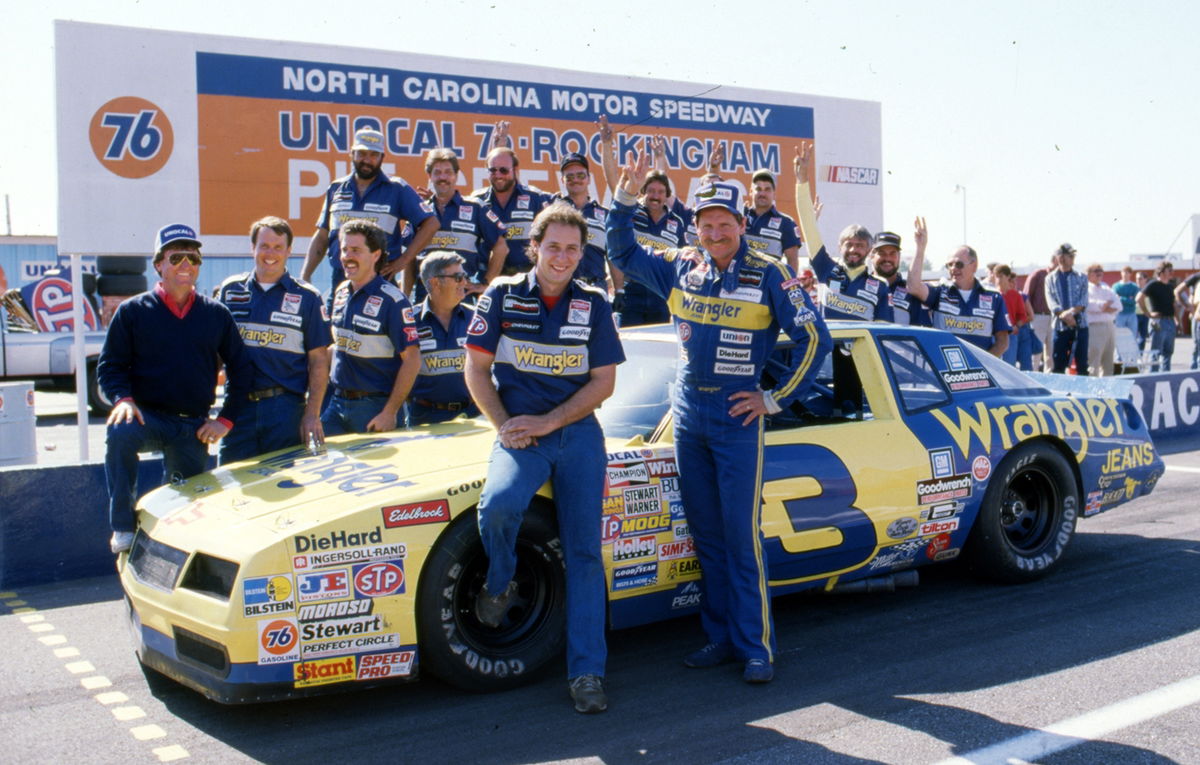
Imago
From 1985-88, Richard Childress Racing’s pit crew – a/k/a The Junkyard Dogs – swept the Unocal World Pit Crew Championship at North Carolina Motor Speedway. NASCAR Permanent Collection, gift of Bill Joyner

Imago
From 1985-88, Richard Childress Racing’s pit crew – a/k/a The Junkyard Dogs – swept the Unocal World Pit Crew Championship at North Carolina Motor Speedway. NASCAR Permanent Collection, gift of Bill Joyner
With Stellantis returning Dodge to the Truck Series, a Cup Series comeback doesn’t seem far-fetched. While no plans have been announced for the same yet, discussions around possible unions have already started. As Kaulig Racing takes Dodge’s banner for the Truck series from next year, the closest name that has popped up is Richard Childress Racing, and for good reasons.
Watch What’s Trending Now!
Since RCR entered the Cup Series in the 1960s, it has fielded General Motors cars like Chevrolet. However, with Hendrick Motorsports fixed in the top spot, RCR didn’t find the chance to climb the ladder. If RCR wants a better shot at the Cup title since 1994, becoming the top team for another manufacturer makes sense. Moreover, RCR, with its engine program, could then supply engines to other Dodge-backed teams.
At the same time, RCR can provide its sponsorships, complete facilities, a strong engine department, and drivers like Austin Dillon and Kyle Busch to aid in Stellantis’ vision. And it’s not the first time that the two names have been brought together. Back in 2013, just a couple of years after Dodge left NASCAR because it could not secure an organization equal to Penske Racing’s stature, whispers made rounds about RCR’s possible Dodge connection. Already by then, RCR boasted six Cup titles, three Nationwide Series championships, and two Truck titles.
ADVERTISEMENT
But owner Richard Childress had addressed the rumors head-on back then, stating, “I haven’t talk to anybody. No one has approached me yet.” While the talks didn’t last long then, now, almost a decade later, a Dodge-RCR union could be possible. Kaulig’s connection with both RCR and Dodge only spikes the conversations. But the biggest hurdle in crossing this bridge for Richard Childress would be loyalty.
As mentioned before, RCR has carried Chevrolet’s banner for at least five decades now. While moving to another manufacturer certainly gives it a boost to sweep another title, it might take some deep thinking by Childress. The Athletic’s Jordan Bianchi gave the same analysis in his recent reader’s mailbag when he did not dismiss the possibility but also stated, “Severing these ties would be something team owner Richard Childress, who values loyalty, would not do without great hesitation.”
Still, the allure of leading Dodge’s potential Cup return, fueled by Ram’s Truck Series momentum, could outweigh tradition. Although it’s a thought for when Dodge actually enters the Cup series, the fans have already given their verdict.
ADVERTISEMENT
Fans weigh in on the speculation
One fan captured the internal tug-of-war at RCR, noting, “Austin wants it; RC doesn’t.” Richard Childress’s grandson, and a driver since 2014, has voiced ambitions for growth amid inconsistent results. Childress, who built RCR from a single-car operation in 1969 into a multi-series powerhouse, prioritizes stability, but Dillon’s push for innovation echoes broader calls for RCR to adapt in an evolving landscape dominated by top-tier alliances.
ADVERTISEMENT
Shifting to calls for change, another commenter suggested, “Somebody needs to send Gordon Ramsay to RCR. He’s good at getting old people who have no business running restaurants to hang it up; maybe he could convince RC to finally retire to the farm.” This jab highlights frustrations with RCR’s recent performance, stuck without a championship since Dale Earnhardt‘s era ended in 1994, as newer teams like Trackhouse Racing surge ahead. Fans see Childress, now in his late 70s, as resistant to modernization, drawing parallels to outdated businesses needing fresh leadership to reclaim relevance.
Another fan opined, “From a business perspective, it makes perfect sense. Be the 3rd-4th tier Chevy org or be the lead Dodge org. RC is still thinking like it’s 1990.” This underscores RCR’s current standing in Chevrolet’s hierarchy, where resources flow primarily to Hendrick, leaving RCR with limited factory backing despite its engine contributions to allies like Kaulig and Trackhouse. Embracing a lead role with a returning manufacturer could boost funding and tech, much like Toyota’s entry in 2007 elevated partnered teams.
The unique asset of RCR also draws attention. One fan remarked, “They’re the only team with an engine shop that isn’t in a symbiotic relationship with their manufacturer. If I were Dodge, I’d keep adding zeroes to the check until Pop-pop gave in.” ECR Engines, formed in 2003 through a merger, stands out as independent, powering multiple outfits beyond RCR. Not to mention, Kaulig handles ECR and is already tied to Dodge for the Truck Series. This setup positions RCR for Dodge, which would need a reliable engine supply upon re-entry, similar to how Ford and Toyota integrate with Roush Yates and TRD.
ADVERTISEMENT
And then enthusiasm bubbles up in comments like, “RCR and ALL BLACK DODGE RAAAAMS! That’s a match made in Wayne County heaven right there.” This nods to RCR’s North Carolina roots in Welcome, near Wayne County, and its iconic black schemes from Earnhardt’s No. 3 days. Pairing with Ram’s rugged branding could revive that intimidating aesthetic, appealing to fans nostalgic for dominant eras while aligning with Stellantis’s push for bold, performance-driven identities in racing. While the talks are still in the works, it seems like the fans are down for RCR to join hands with Dodge. But will Childress leave Chevrolet after five decades?
ADVERTISEMENT
ADVERTISEMENT
ADVERTISEMENT

